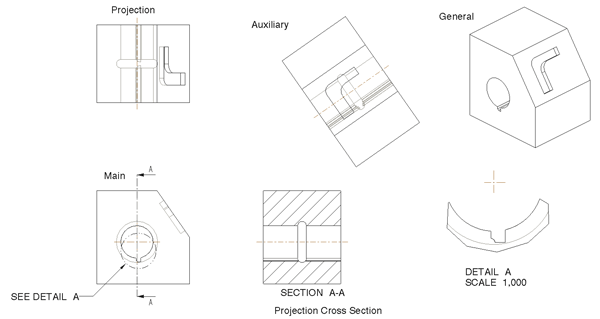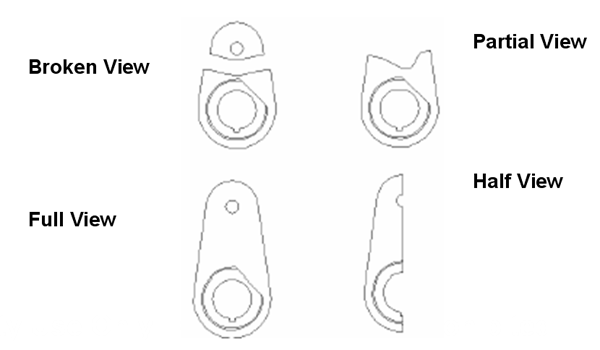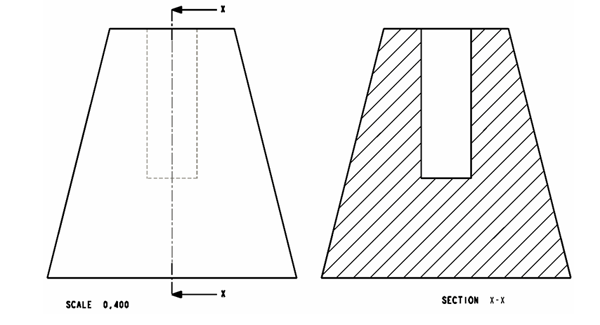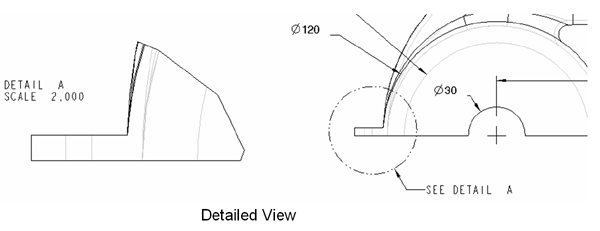types of 3d drawing views
Calculation Drawing Views � [RMB card]
The first view must be a general view. Use the Drawing View dialogue box to set upwardly your first view.
Your first view will probably exist an orthographic view. Either utilise the list of saved views [from the model] to fix its orientation or orientate the view manually using the Geometric References or Angles options.
Brand sure yous ready a view scale to brand best use of the sheet expanse.
Double-click a view to change its properties.
Other views such equally, Detailed views, should be added through the Insert > Drawing View drib downward menu.
Types of Views
The master view types available in the VIEW TYPE bill of fare (illustrated in figure below) are:
- General � A view that yous orient and is non dependent upon any other view for its orientation.
- Projection � An orthographic project of an object as seen from the front, acme, right, or left. First or 3rd bending?
- Auxiliary � A view created by projecting xc degrees to an inclined surface, datum plane, or along an centrality.
- Detailed � A view that yous create by taking a portion of an existing view and scaling it for dimensioning and clarification purposes. The boundary for the detailed view can exist a circle, ellipse (with or without a horizontal or vertical major centrality), or a spline.

Click above prototype for bigger picture
Specifying How Much of the Model Is Visible
Using other options in the View Properties > View Type window, you can specify how much of the model is visible in the view, as shown in the next figure.
- Full View � Shows the entire model.
- Half View � Shows only the portion of the model on one side of a datum airplane.
- Broken View � Removes sections from large objects between two points and moves the remaining sections close together.
- Partial View � Shows just the portion of the view that is independent within a boundary.

Adding a Cross Section
A cross exclusive view is often needed to clarify internal particular � remember, never dimension subconscious detail, dimension the cross section. A perpendicular datum plane in the parent view is used as the �cutting� plane to allow a projected view to be showed in Cross Section [xsec]
To show the view as a cross-department, use the View Properties> Sections window options. Either pick an existing xsec (which should be created in the model file - run into Hither ) or create a new planar section.
Adding department arrows

Arrows are needed in the parent view to show the position of the cutting airplane. Pick the xsec view > RMB and choose add arrows > choose the view to which to add together the arrows.
Calculation a Detailed View
-
Insert > Drawing View > Detailed View
-
Pick a signal on the part to show the centre of the detailed area
-
You are prompted to draw a spline curve to represent the extents of the detailed area
DON'T start the spline tool from the sketch toolbar, just start picking points to prove the area. -
Centre mouse button to terminate the spline
-
Pick a position to place the view
-
Change the scale accordingly

Isometric View
An isometric view can help us improve visualise the 3D form. Use the orient view icon in the office file to create an appropriate view or the view orientation area of the view backdrop dialogue box to create your view. Rotate effectually the vertical axis 45 degrees, rotate around the horizontal axis 35 degrees.
Videos
General orthograpic view - Here
Isometric vew - Here
Cross Department (x-sec) view - HERE
Detailed view - HERE
Line display
The settings wireframe, subconscious line, no hidden line or shaded will touch the way your view are displayed. Showing hidden detail is the preferred option, but if this makes the view unreadable considering of an farthermost corporeality of internal particular then employ no subconscious line � make sure you are consistent in any associated views
The line display setting can be controlled independently within each view through the view backdrop window. Isometric views are generally not shown with hidden line detail, their main role is to evidence the full general form.
Multiple parts on single canvas
If you desire to separate your sheet into areas and details multiple parts then:
File > Properties > Cartoon Models > Add Model
Then utilise the Set Model option to switch active models. Brand sure you separate your canvass and have a details table for each model.
Multiple Sheets
If you cannot include enough adequately sized views on a sail to fully explain your model so add sheets to the engineering drawing:
Insert > Canvass
Fill in the table info as earlier. Employ the box in the tiptop toolbar to switch between sheets.
�wysiwyg�
What you lot see, is what y'all get � your file will print as information technology is shown on screen. Plow off display of reference geometry [planes and csys], switch to hidden line. E'er do a test print so fine tune the drawing. Although hidden lines show in grey on the screen they will print equally the standard dashed lines.
Watch the ProE print defaults. When yous hitting the ![]() impress icon, the arrangement should be configured to impress �Full Plot�, that is, i:1. If it doesn�t then your calibration volition exist wrong. Change the setting in the ProE print window � Configure > Model > Full Plot
impress icon, the arrangement should be configured to impress �Full Plot�, that is, i:1. If it doesn�t then your calibration volition exist wrong. Change the setting in the ProE print window � Configure > Model > Full Plot
Show the associativity between the cartoon the and the model file.
If you open and modify the file to which your cartoon is associated so regenerate the drawing file it will be updated according to those changes.
Once you have applied dimensions to the drawing these tin can as well exist used to change the office file.
Deleting unwanted lines
Common situation is when you accept a mirrored part with normalcy across the symmetry plane or merged surface patches at G2/curvature continuous - this will create tangent/patch edges which shouldn't be at that place as there is no sharp change in radius.
Too, stray, random lines tin be created if the system cannot fully resolve the geometry.
View > Drawing Display > Border Display > Erase Line
Source: https://learn.lboro.ac.uk/ludata/cd/cad/eng_draw/eng_draw_views.htm
0 Response to "types of 3d drawing views"
Post a Comment